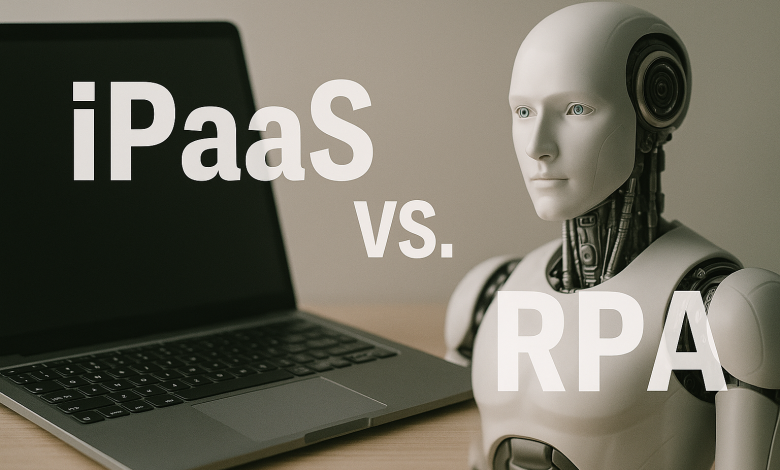
The pressure is on. Every IT leader, CTO, and Business Process Owner is tasked with accelerating operations, reducing errors, and getting more from existing technology. You’ve likely heard the buzzwords, RPA (Robotic Process Automation) and iPaaS (Integration Platform as a Service) and now face a strategic question: which platform deserves your investment?
The core mistake many businesses make is treating iPaaS and RPA as competitors. They are not. They are two distinct tools designed to solve two fundamentally different types of problems, one for data flow, the other for user interaction. The choice isn’t about which one is “better” overall, but which one is the right fit for your automation goal. The need for reliable, high-volume data flow is a constant across industries, from finance to modern retail, where having a robust Shopify integration platform is a foundational requirement for growth.
This guide cuts through the marketing noise to give you a clear, strategic breakdown.
The Core Difference: How Do They Automate?
To choose the right solution, you must first understand the mechanism by which each technology achieves automation.
What Problem is RPA Designed to Solve?
RPA automates by mimicking human actions on a user interface (UI). Think of it as a digital worker sitting at a computer, logging into applications, reading screens, clicking buttons, and copying and pasting data.
- Mechanism: UI-based. It relies on the visual presentation of an application.
- Best Use Case: Automating repetitive, rule-based tasks trapped in legacy systems that lack a modern API, or where the task is small and simple (the “last mile” of automation).
- Analogy: RPA is a highly efficient virtual assistant operating a keyboard and mouse.
What Problem is iPaaS Designed to Solve?
iPaaS automates by connecting applications and systems directly at the back end using their APIs (Application Programming Interfaces). It is a cloud-based platform that orchestrates complex, end-to-end workflows between disparate systems.
- Mechanism: API-based. It relies on the stability of the application’s programming interface, not the visual screen.
- Best Use Case: Achieving reliable, high-volume, and real-time data synchronization and complex, mission-critical workflow orchestration across dozens of cloud and on-premise systems.
- Analogy: iPaaS is the system architect building stable, multi-lane highways between your applications.
The E-commerce Test: Comparing Mission-Critical Use Cases
Where the rubber meets the road is in mission-critical operations, especially in digital commerce, where the consequences of data errors are immediate and costly.
When Does iPaaS Win on Data Integrity and Scale?
For a modern business, the core need is guaranteed, real-time data integrity between your customer-facing platforms and your financial systems. This is where iPaaS is non-negotiable.
Consider a scenario like processing an order:
- A customer places an order on your storefront (e.g., Shopify).
- Inventory is updated in real-time.
- The order is pushed to the ERP/Financial system (e.g., Business Central).
- Shipment tracking is synced back to the storefront.
This entire process relies on resilient, API-driven data exchange. iPaaS includes robust error handling, monitoring, and data transformation—guaranteeing that data like inventory levels and order details remain consistent across all systems. High-volume, reliable data integration, such as a full Shopify Business Central integration, is an inherent function of iPaaS.
The Real-Time Requirement: iPaaS facilitates event-driven architecture, moving data instantly upon an event occurring. This is vital for operations to prevent overselling and ensure accurate inventory across channels.
When Does RPA Win on Interaction and Legacy Access?
RPA excels where APIs fail to exist. If a small, necessary part of your process involves:
- Logging into an antiquated, in-house finance application that has no modern API.
- Scraping data from unstructured documents or a specific legacy reporting screen.
- Filling out a web form that cannot be easily modified.
In these “last mile” scenarios, RPA can provide a fast, non-invasive, and cost-effective quick fix because it requires no deep integration or system changes.
The Strategic Investment Breakdown
Choosing between the two is a major investment decision. IT leaders must look beyond the initial setup cost and evaluate long-term scalability, fragility, and maintenance.
Which Platform Offers Better Scalability and Maintenance?
The biggest differentiating factor is the cost of change and maintenance.
| Feature | iPaaS (API-Based) | RPA (UI-Based) |
| Scalability | High. Cloud-native; scales horizontally with transaction volume (data flow). | Limited. Scales by deploying more bots; bottlenecked by application UI speed. |
| Fragility | Low. APIs are versioned and stable; unaffected by UI changes. | High. Bots break when the UI (screen) changes (e.g., a button moves). |
| Maintenance | Low. Platform vendors maintain connectors; updates are automatic. | High. Requires specialized staff to constantly review and update broken scripts. |
Consultative Insight: The maintenance cost of RPA is often the hidden trap. While RPA projects can typically see ROI within 12 months for simple, structured tasks (Forrester), that ROI quickly erodes if the underlying application updates its UI.
iPaaS offers superior resilience. Because it connects directly to the API, it remains stable even if the application’s user interface is completely redesigned. This inherent stability drastically reduces operational overhead for your IT team.
How Do Governance and Security Compare?
For modern enterprises, integration cannot be a security liability.
- Security: iPaaS handles data via secure, encrypted backend protocols. The platform is designed with enterprise security and governance in mind. RPA, by design, must store and use user credentials to log into applications and interact with the screen, which introduces different security and compliance complexities.
- Governance: iPaaS provides centralized, system-generated audit trails and error logging for every data movement, which is essential for compliance and troubleshooting. With RPA, auditing is limited to the bot’s on-screen activity logs, offering less comprehensive data flow governance.
Industry data confirms the strategic choice: iPaaS is projected to dominate the automation and integration market, growing from approximately US17.4 billion by 2027, solidifying its position as the core strategic platform for application and data integration (Nasdaq).
The Path Forward: A Unified Approach
So, should you choose iPaaS or RPA?
The answer, in most complex enterprise environments, is that you should strategically plan to use both. They are complementary pieces of a complete automation puzzle.
- iPaaS is the Backbone: Use it for high-volume, mission-critical system-to-system integration where data integrity and scalability are paramount. This includes all your financial, inventory, CRM, and ERP data flows.
- RPA is the Specialist: Use it sparingly to address low-volume, tactical, legacy “last mile” problems where the lack of an API forces you to interact with a UI.
The Strategy: Focus on building your core data foundation first. Establish iPaaS as the central nervous system that ensures smooth, reliable data flow between your major platforms. Then, and only then, use RPA to tactically solve the unavoidable UI-based challenges that remain.
Conclusion: Making Your Strategic Automation Choice
Choosing the right automation platform is not a tactical expense, it’s a long-term strategic investment.
Your decision must be driven by the nature of the challenge:
- Need scalable, reliable data flow and system connectivity? iPaaS is the definitive solution.
- Need a quick fix for a single, small, manual task on a legacy UI? RPA is the suitable tactical tool.
By implementing iPaaS first, you establish a resilient, API-driven architecture that will adapt and scale with your business, guaranteeing that you solve your automation challenges without creating an unmanageable pile of technical debt.




